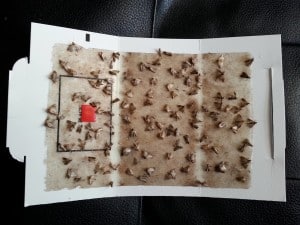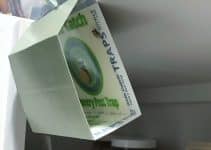Every month CleanerToday sponsors a photo contest in which customers are invited to send us their most impressive photo showing the outstanding pantry moth catching ability of pantry moth traps. Many times, a picture does truly speak a thousand words, or in this case, at least dozens of pantry moths.
Customers who submit one of the five best photos of the month receive a gift certificate that can be redeemed for a set of two pantry moth traps. In addition, all customers who submit a photo showing a used pantry moth trap with at least 10 pantry moths caught will receive 10% off coupon to be applied to a future order. At CleanerToday, it pays to take and submit a photo of your pantry moth trapping success stories.
This photo was submitted by a customer in Maine who placed the pantry moth trap in her kitchen, a common location for pantry moths to appear. As you can see, she had great success with trapping pantry moths using our pantry moth traps. We hope that she went on to be able to completely eradicate the problem just as many of our customers are able to catch enough moths to break the infestation cycle
An important thing to understand about pheromone attractant traps such as these pantry moth traps is that they are designed to only trap male pantry moths that are of breeding age. Moth Trap catching power comes from the Pheromone lure. The pheromone matches the “scent” (humans can’t smell it, but moths can!) released by the female pantry moth when she is ready to mate. Over time, by trapping and eliminating the male pantry moths, the life cycle is broken and the infestation is cleared.
Some customers are disappointed that once they have opened the trap that pantry moths don’t start to swarm into it, or that even after a few days there may be few, if any, pantry moths trapped, and perhaps not unreasonably they angrily conclude that the trap is defective. The problem here is simply one of a bit of knowledge and understanding and we hope to be able to help with that.
The pantry moth life cycle is variable and can range from as little as 21 days to up to 8 weeks. So, what this means to a customer looking to trap pantry moths is that depending on where in the life cycle your pantry moths happen to be, the males may well not yet be ready to mate and therefore won’t be attracted to the pheromone until they mature, a process, as noted above, that takes a highly variable amount of time. It is possible that in the cooler months, or in the generally cooler higher latitudes, such as in Maine, that the pantry moth life cycle may tend toward the longer range.
As is often the case when dealing with pest infestations, patience is a weapon you have to employ. Place the traps as directed and then wait, potentially for several weeks depending on where in the pantry moth life cycle you happen to attempt to intervene, for the best results. We have rarely, if ever, encountered a situation in which our pantry moth traps failed to work when used as directed and when allowed adequate time to do the job. Remember that the infestation didn’t happen in a day and it will likely take more than a day to resolve, but with some patient knowledge, you can prevail over even the worst pantry moth problem, and we are here to help!


